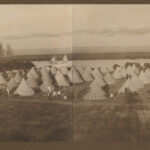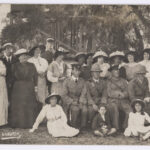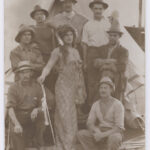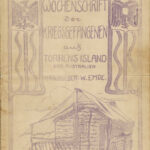German settlers arrived in South Australia shortly after the first non-indigenous settlers in the colony. By the early twentieth century German settlers and their descendants made up almost 10 percent of the state’s population. With the outbreak of the First World War, the loyalty of the German community in Australia was called into question. Camps were set up around the country for the internment of subjects of nations at war with Australia, most of whom were German. In South Australia, an internment camp was opened on Torrens Island in October 1914. Its brief history is one of the darker aspects of South Australia’s experience of war on the home front.
A tangible presence
First arriving in 1837, German settlers in South Australia had come for economic, religious and political reasons. They soon established settlements in the Adelaide Hills and further north in the Barossa Valley, and eventually all around the mid-north, east and south east of the state. Most of South Australia’s Germans lived in rural areas, where over decades many preserved their language, their culture and their religion.
South Australia’s German heritage was not only prominent in towns like Hahndorf and Lobethal in the Adelaide Hills and Bethanien and Kaiserstuhl in the Barossa Valley, but also in central Adelaide. Just south of Rundle Street was Adelaide’s German Quarter, which included three German churches, the German Club and the Menz Biscuit Factory on Wakefield St and several pubs with a German character, like the Tivoli, where German farmers gathered on town visits. On Rundle Street were institutions like the German confectioner Carl Stratmann at Beehive Corner and Café Kindermann.
From friends to ‘enemy aliens’
Germans and their descendants were prominent in many fields, and most of South Australia’s Germans combined a love of German culture with a strong political loyalty to Australia. And they were well accepted by their non-German neighbours.
International tension between Britain and Germany in the first decade of the twentieth century was reflected locally, however, and the loyalty of those of German birth and ancestry began to be questioned. This questioning intensified with the outbreak of the First World War.
Despite pledges of loyalty from the German community and calls for tolerance from leading figures like the premier, Archibald Peake, on 10 August 1914 (five days after Australia entered the war) all German subjects living in or visiting Australia had to report to their local police station. When war was declared against Austria on 12 August the requirement was extended to Austrian subjects. Those reporting were registered, and then asked to give their ‘parole’, to swear that they would not take any action against the British Empire during the war. Most were then required to report to the police station each week.
From September all subjects of an enemy power – ‘enemy subjects’ – who were members of the military reserve of their home country, and those of military age found on ships, were interned. From October all ‘enemy subjects’ whose conduct was considered ‘suspicious or unsatisfactory’ were interned. The October War Precautions Act gave the Australian Government the power to intern any naturalised British subjects believed to be ‘disaffected or disloyal’. From December all internees were treated as prisoners of war.
Internment camps were established across Australia. In South Australia an internment camp was established on Torrens Island. Opening on 9 October 1914, it was known as Torrens Island Concentration Camp.
Early in the war most internees were men who had been refused parole. They were joined by sailors and ships’ officers. As the war continued, some of those who had given their parole failed to comply with its terms, and were interned for not reporting as required, or because authorities judged that they had acted disloyally. These men sometimes had no idea why they were behind the wire. Others surrendered themselves for internment on Torrens Island because they were destitute. The economic impact of the war and the rise of anti-German feeling left many ‘enemy subjects’ living in Australia without work or any source of income.
Of the 400 or so men who were interned on Torrens Island, about 350 were German subjects. Many of those men had lived and worked for years in South Australia. Of the remaining prisoners, just over twenty men were from Austria-Hungary, and one was from Turkey. About ten prisoners were naturalised British subjects.
Details of life in the camp have survived largely thanks to the photographs taken by Paul Dubotzki and the diary kept by Frank Bungardy, two of the prisoners interned on the island.
Life on Torrens Island
Most prisoners lived behind the barbed wire fence of the main camp, known as ‘the German lines’. Seven or eight prisoners were allocated to each tent, and each was issued a waterproof sheet, two blankets and the makings of a mattress. Bungardy described how the men in his crowded tent ‘layd hudled together like Pigs in a stye during the nights’. The daily distribution of rations (meat, potatoes, some vegetables, bread, jam, coffee, sugar, salt, and pepper) every afternoon at 3 was the only event on the daily calendar. One of the main challenges for prisoners was finding ways to relieve the monotony of long days in bleak surroundings.
Gambling on cards and two-up was popular, as were physical pastimes like athletics and German football. Music provided amusement and consolation. Prisoners organised a choir and at least two bands.
Many a long weary hour during the hot evenings we amused ourself, laying in a circle in the soft sand enjoying German Ballats, dittis, Soldiers and National songs. If it hadnt been for this their would have been a few more driven mad…
Frank Bungardy
Internees were not allowed outside books or newspapers, but they produced three issues of their own newspaper, called Der Kamerad. It featured accounts of camp life and illustrations, as well as advertisements for businesses run within the camp, including Electra tattoos and the Kaiser Café.
Meanwhile, the guards lived in adapted buildings or under canvas. Military training for young men had been compulsory since 1911, and following the outbreak of war many of those who had military training volunteered to serve either in the armed forces overseas or, like those at Torrens Island, in home defence. Prisoners and guards alike lived with the boredom and physical discomfort of life on the island, and originally relations between the two groups of men were familiar and discipline fairly relaxed. The internees even held an extravagant celebration for Kaiser Wilhelm II’s birthday on 27 January 1915, with a parade followed by sporting competitions and singing and dancing.
A turning point in relations between the guards and the prisoners appears to have been the appointment of Captain George Edward Hawkes as camp commandant in early 1915. The camp was moved to the southern end of the island and relations between prisoners and guards deteriorated. A series of incidents followed. Prisoners keen to salvage building materials dismantled a disused shed – an action later described by guards as a riot. A general round-up followed, and about two dozen men were held in a barbed wire compound overnight, in the rain, and for the next fortnight. The next morning Hawkes shot into a tent, wounding a prisoner. The prisoner claimed he had asked Hawkes for a cigarette. Hawkes claimed he had been called a monkey.
Tension continued to rise. One night in June two prisoners escaped, getting out through the drains and crossing the river in a stolen boat. Recaptured and returned five days later, they were tied to a tree, stripped, and whipped with a cat-o-nine tails, while guards and prisoners watched. Dubotzki photographed the prisoners’ wounds in the camp hospital, and prisoners succeeded in using the evidence to draw the attention of military authorities to their brutal treatment. An enquiry was held Hawkes was stripped of his commission. A second enquiry, held in 1916, concluded that Hawkes had exceeded his powers, and that had a full investigation been made earlier it might have resulted in better conditions and fairer treatment of prisoners on the island.
Although only men were interned in the camp, women and children were also deeply affected by internment. Prisoners could send only two letters each week. Short visits from family members were permitted but lasted only as long as it took to unload the motor launch. For most families internment also meant the loss of the breadwinner. The Australian Government paid an allowance to families of internees of 10 shillings per week, plus two shillings and sixpence for up to three children under 15. Bungardy called it a ‘starvation allowance’, and pointed out that difficult economic circumstances only added to the unjust burden borne by women unfortunate enough to be married to men who had become ‘enemy subjects’, and then interned, due to conflict on the other side of the globe.
The camp closes
There were almost 400 internees on Torrens Island by the time the camp closed in mid-August 1915, in the wake of the enquiry over brutal treatment of prisoners. Two dozen prisoners were released in its final fortnight. But most were sent on trains under heavy guard to the ‘German Concentration Camp’, Holsworthy, at Liverpool, south-west of Sydney. More fortunate prisoners were sent to a camp at Trial Bay on the northern coast of New South Wales.
Anti-German feeling continued to shape South Australian society for the course of the war. When the First World War finally ended in November 1918, some internees were released, including most of the South Australian Germans who had been naturalised before the war, and all those born in South Australia. But most continued to languish in the camps while the Australian Government organised their deportation to Germany. Troop ships that had just disembarked Australian soldiers returning from Europe were loaded with ex-internees for the return trip. Some of those deported later returned to Australia to re-make the lives interrupted by war.
The experiences of those men who, because of events on the other side of the globe, found themselves interned on Torrens Island are part of the multi-layered history of South Australia during the First World War. The story of Torrens Island Concentration Camp raises enduring questions about identity, community and the power of governments in times of crisis.









Comments
3 responses to “Torrens Island internment camp”
My Grandfathers brother Carl Witt was an internee, having arrived in 1914 and sent to Torrens Island. He was deported in 1919 and sadly never heard of again by our family. Any German records of these arrivals would be welcome information as to his whereabouts from 1919 onwards.
Hi Graham, that’s a terribly sad story. I understand that the many of the sources for the exhibition and publication on the same topic as this article (Monteath, P, Paul, M and Martin, R, Interned: Torrens Island, 1914-1915 (Adelaide: Wakefield press, 2014) came from the National Archives: http://www.naa.gov.au/ You might try there to start.
Graham, I appreciate that time has passed you made this enquiry, yet I have only just seen your posting. Perhaps the matter has been resolved. Potentially the following information does not relate to a member of your own family. Maybe you already know about this situation anyway …
Be that as it may, it could still interest you to learn that two different print-based sources point out that a teacher from the Lutheran school at Tanunda faced a serious charge during World War 1, simply because he was found to have still been in possession of tickets for a fund-raising concert.
‘German Australians’, by Al Grassby and Marji Hill (Macmillan, 2000) states that a German schoolteacher from Tanunda was accused of undermining the war effort by being found not to have sold all the tickets he had been supplied with, for a Red Cross concert, with his own home searched to gain such evidence.
A second source ‘The Germans in Australia’, by Ian Harmstorf and Michael Cigler (Australian Ethnic Heritage Series, AE Press, 1985) gives much the same information, while specifying that the teacher’s name was Witt, adding that he was identified by an informant for sabotaging the war effort, with an official conclusion reached that he was a saboteur.
Hopefully you have since learned more about the fate of your grandfather’s brother Carl, after World War 1 – if he was indeed this teacher, then this may give you a greater sense of the challenges he faced here during that war as well.